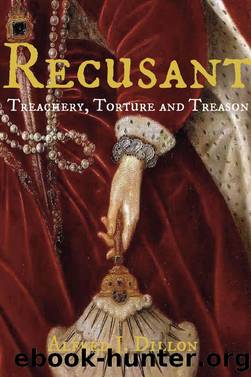Recusant by Alfred Dillon

Author:Alfred Dillon [Alfred J. Dillon]
Language: eng
Format: epub
ISBN: 9781910050873
Publisher: Arcadia Books Limited
Published: 2016-12-15T00:00:00+00:00
NICHOLAS OWEN
Any examination of the Jesuitsâ presence in England would not be complete without a few words on the Orderâs master craftsman Nicholas Owen. If John Gerard represented the loud, popular face of the Jesuit mission, Owen represented the quiet diligence and ingeniousness that the Jesuits brought to Englandâs towns and cities.
The son of an Oxford carpenter, Nicholas Owen was one of four brothers, two of whom became Jesuit priests, while the other ran a secret press responsible for printing much of the Catholic literature available at that time. Physically, Nicholas had been born at a disadvantage â he was small, barely larger than a dwarf, and he also walked with a limp. Living in an age when physical disability was believed to connote impropriety of thought and spirit, Nicholas had to rely on his remarkable mind to make his mark.
Unlike the other Jesuits, Nicholas had never been to Rome â his formal training had come at the feet of one of Oxfordâs more prominent joiners, William Conway. In 1577, at the behest of his father, Owen had undertaken an eight year apprenticeship during which time he would learn how to construct not only furniture but also the houses in which to put it. In both matters, craftsmen were expected to work with subtlety, creating ornate yet delicate furnishings, a task made more difficult given that the building material of the day was the altogether unwieldy English oak. Owenâs actions in the four years following his apprenticeship were not recorded, although an unspecified joiner did present himself to Henry Garnet in 1588 or â89 asking to help as best he could. This was most likely Nicholas Owen, whose skills, thanks to the events of the previous eight years, had become surprisingly invaluable.
With the passing of the 1585 Treason Act which forbade the shelter of seminary priests ordained after 1558, the Catholic laity found itself at a crossroads. Should they continue to risk their lands and even their lives by opening their homes to the seminary priests? Or should those priests have to shoulder the burden for their own upkeep at the various inns and taverns of Englandâs highways, and only make house calls when explicitly sent for?
Several prominent Catholics met that year to discuss this very question. They concluded that, given the punishments involved, the risks were too great and that priests would have to fend for themselves. A small collection was taken from which the priests would then receive a monthly stipend, but without safe houses in which to hide from their pursuers their life in England was about to become infinitely more dangerous.
Unsurprisingly the Jesuits pushed for a more mutually satisfactory solution. The following year another conference was held, attended by Henry Garnet and his predecessor as Jesuit Superior William Weston (from whom Garnet took over that year, Weston having been arrested in late 1586). Naturally enough, the conversation turned to the topic of âhidesâ, those parts of the house in which priests would conceal themselves when the authorities arrived to search the premises.
Download
This site does not store any files on its server. We only index and link to content provided by other sites. Please contact the content providers to delete copyright contents if any and email us, we'll remove relevant links or contents immediately.
Room 212 by Kate Stewart(5016)
The Crown by Robert Lacey(4710)
Endurance: Shackleton's Incredible Voyage by Alfred Lansing(4656)
The Iron Duke by The Iron Duke(4275)
The Rape of Nanking by Iris Chang(4125)
Joan of Arc by Mary Gordon(4000)
Killing England by Bill O'Reilly(3940)
Say Nothing by Patrick Radden Keefe(3892)
I'll Give You the Sun by Jandy Nelson(3344)
Shadow of Night by Deborah Harkness(3279)
Hitler's Monsters by Eric Kurlander(3256)
Mary, Queen of Scots, and the Murder of Lord Darnley by Alison Weir(3138)
Blood and Sand by Alex Von Tunzelmann(3121)
Darkest Hour by Anthony McCarten(3058)
Eleanor & Park by Rainbow Rowell(3042)
Margaret Thatcher: The Autobiography by Thatcher Margaret(3021)
Red Famine: Stalin's War on Ukraine by Anne Applebaum(2859)
Book of Life by Deborah Harkness(2855)
The One Memory of Flora Banks by Emily Barr(2791)
